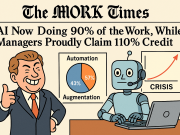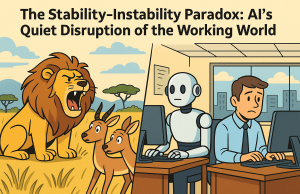In a world shaped by rapid technological advances, climate goals, and fluctuating policies, organizations are constantly navigating uncertain territory. The latest example of this volatility comes from policy reversals on remote work, such as former President Donald Trump’s call for a ban on remote work for federal employees. While this decision primarily aims to address productivity concerns and organizational control, it underscores a larger question: How adaptable are today’s workforces to sudden policy shifts?
Remote work policy reversals not only disrupt established routines but also create ripple effects on workforce productivity, employee well-being, and environmental sustainability goals. Organizations that can assess and enhance their adaptability will be better positioned to maintain performance, innovate, and contribute to long-term sustainability efforts.
The Remote Work Pendulum: From a Pandemic Necessity to Policy Reversals
During the COVID-19 pandemic, remote work transformed from a rare perk to a global necessity. Companies that had never considered remote work were forced to quickly adapt, implement digital tools, and shift operations to virtual environments. This transition provided numerous benefits, including increased flexibility, reduced commute times, and improvements in work-life balance.
For many industries, remote work proved successful, and studies showed productivity gains of 13% in some sectors, especially for knowledge-based workers. The environmental impact was also significant, with fewer commuters leading to reduced traffic congestion and lower carbon emissions. However, as the world reopened, companies and governments began reconsidering the role of remote work, questioning its impact on long-term productivity and collaboration.
Enter the remote work ban. Policy reversals like this disrupt workflows that have become ingrained over several years and test the adaptability of employees, managers, and organizations as a whole.
How Remote Work Policy Reversals Disrupt Workforce Productivity
- Cognitive Load Increases During Transitions
Sudden changes to work arrangements introduce new cognitive challenges, forcing employees to quickly adjust to different routines, communication norms, and productivity expectations. Workers accustomed to managing their time flexibly in remote environments may struggle with office-centric schedules, which can lead to decreased performance in the short term.- Statistic: Studies by the American Psychological Association indicate that abrupt changes to work routines can reduce individual productivity by up to 20% during the initial transition phase.
- Impact: Workers face an increased mental burden as they juggle changing expectations, commute times, and potential disruptions in their personal lives.
- Collaboration and Team Dynamics Are Disrupted
Remote work arrangements rely heavily on asynchronous communication, virtual meetings, and collaborative tools that differ from in-person collaboration. When policies change suddenly, teams may experience misaligned workflows, communication breakdowns, and unclear role expectations.- Example: A team used to collaborating through shared cloud documents may face challenges when returning to an office environment without the same level of digital integration.
- Result: Initial disruptions in collaboration can delay project timelines and create confusion about task ownership during the adjustment period.
- Loss of Employee Autonomy Reduces Motivation
Many employees value the flexibility that remote work provides. It allows them to optimize their work hours, balance family commitments, and work in environments that suit their productivity needs. A sudden shift back to in-office work removes that autonomy, leading to reduced job satisfaction and decreased motivation.- Survey Insight: A McKinsey study (2022) found that 87% of workers would prefer at least some remote work options, and 62% of employees are more likely to stay with an organization if flexible work arrangements are available.
- Impact on Retention: Policy reversals that remove flexibility can lead to higher turnover rates and difficulty retaining top talent.
The Sustainability Dilemma: Remote Work’s Environmental Benefits
One of the often-overlooked aspects of remote work reversals is their impact on environmental sustainability goals. Remote work played a crucial role in reducing carbon emissions, traffic congestion, and energy consumption during the pandemic. In cities where remote work became the norm, air quality improvements were notable, and transportation-related emissions decreased significantly.
- Statistic: According to the International Energy Agency, remote work reduced daily global CO2 emissions by an estimated 17% during peak lockdown periods in 2020.
- Reversal Impact: A mass return to office environments will increase daily commuting, leading to a potential rebound in carbon emissions and offsetting previous gains in sustainability.
Moreover, remote work supports decentralized living—allowing people to work from areas with lower housing costs and less urban congestion. Policy reversals may force workers to relocate back to expensive urban centers, increasing urban density and environmental strain.
Adapting to Change: How Organizations Can Mitigate Disruptions
Conduct Change Impact Assessments:
Before implementing major policy changes, organizations should assess the potential impact on productivity, employee morale, and sustainability objectives. Surveys, performance reviews, and adaptability assessments can help leaders make data-driven decisions rather than blanket mandates.
Flexible Hybrid Models:
Instead of enforcing rigid work arrangements, companies can explore hybrid models that provide flexibility while ensuring in-person collaboration when needed. Hybrid setups are linked to higher employee satisfaction and sustained productivity, offering the best of both worlds.
- Key Insight: A study by Deloitte found that companies with hybrid work models experienced higher productivity and retention rates compared to fully remote or fully in-office setups.
Enhance Reskilling and Adaptability Programs:
Organizations can mitigate disruptions by investing in reskilling programs that enhance employee adaptability. Workers with strong adaptability skills can quickly adjust to new work environments and maintain performance levels. Programs that foster adaptability focus on problem-solving, emotional resilience, and collaboration.
Monitor Long-Term Sustainability Impacts:
As remote work reversals contribute to increased commuting, organizations should monitor their carbon footprint and explore alternative ways to offset emissions. Solutions could include carpooling incentives, virtual collaboration tools, and sustainable office policies.
Key Takeaways for Future Workforce Policies
- Adaptability is a critical factor: Organizations must prioritize adaptability when implementing policy changes to minimize disruptions.
- Balance flexibility with organizational goals: A hybrid approach is more sustainable than an all-or-nothing policy.
- Sustainability must remain a priority: Remote work’s environmental benefits should not be overlooked when designing future work arrangements.
Conclusion: Lessons from Remote Work Policy Reversals
The evolving work environment requires more than reactive decision-making. Organizations that assess adaptability, balance flexibility, and prioritize sustainability will emerge as leaders in the new work landscape. Policy changes—especially those related to remote work—should be gradual, data-driven, and adaptable to worker needs. By doing so, companies can protect productivity, maintain employee satisfaction, and contribute to long-term environmental sustainability.
The ability to adapt efficiently and thrive during transitions will be the defining factor of a future-ready workforce. As companies navigate these policy shifts, ensuring that their teams can handle disruption will be critical to success.





























